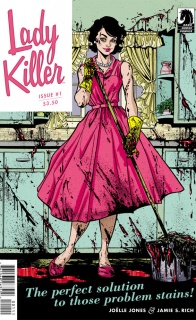She’s an assassin – and a housewife? “Lady Killer” is high-concept camp for sure, but its ingredients are expertly mixed.

Written by Joëlle Jones and Jamie S. Rich
Illustrated by Joëlle JonesJosie Schuller is a picture-perfect homemaker, wife, and mother—but she’s also a ruthless, efficient killer for hire! A brand-new original comedy series that combines the wholesome imagery of early 1960s domestic bliss with a tightening web of murder, paranoia, and cold-blooded survival.
* New original series by Joëlle Jones!
* Dark comedy, gritty action, and killer laughs!
“[Jones] varies her style to suit the mood of each piece, and the results can be spellbinding.”—Powell’s Books
It feels unjust to call “Lady Killer” a derivative comic – even though, at every moment, you’re reminded of other works. I want to call it a pastiche, but even this term has a negative connotation. I can’t see why, though: the Italian root, pasticcio, refers to a delightful mixture of things, a baked meat pie. And really, if you take the 1960s aesthetic, an espionage thriller, and a bit of exploitation fantasy, and bake them for an hour, you will get “Lady Killer” – and something equally as delicious.
An unabashedly violent – and by the end, almost wordless – opening sequence sets the tone. Josie is no black-clad assassin, sneaking into a high-security facility to administer a drop of poison. Her work is messy – hammer-to-the-head, steak-knife-to-the-chest messy, and there are buckets of inky blood. But then Josie frets over a stain on her skirt, and you have this comic in a nutshell.
I’ve been a fan of Joëlle Jones’s work since “Helheim” – her feel for composition and pacing can’t be beat, and the Gothic flavour of her work made that series stand out. Here, as artist and co-writer with Jamie S. Rich, Jones’ flair for the macabre is neatly offset but the homemaker premise, and all kinds of dark comedy gets to sneak in.
Of course, if you look at it too closely, the premise barely sense: it’s hard to believe any homemaker, much less a hemmed-in 1960’s one, could pull off this kind of double life. But step back again, and the broad strokes of the story hang together well enough.
Rich and Jones keep things anchored by – thank God – eschewing that staple, the Grim First Person Narrator. Each scene is constructed from the ground up, with no sweeping generalizations in the caption boxes to distract. We watch Josie from the outside, moment by moment, as she moves from deadly Avon saleswoman to domestic goddess extraordinaire. How’s she going to kill this lady? How’s she going to deal with this phone call? Believable or not, the tension between Josie’s two roles proves compelling at every turn.
Jones’s characters are wound up rather tight; in the best possible way, they always look like they’re lifting something heavy. Watching their expressions twist and warp as their situations worsen makes for compelling page after compelling page.
Josie, of course, gets the best moments – a hint of a smile as she wrestles her mark to the floor, and soulful stare into the distance when she puts off her boss – but the secondary characters catch the eye as well. Josie’s disapproving mother-in-law is vehement enough to be a little scary, while her boss – black-tie formal for no reason at all – brings in smarm by the bucketful.
Jones’s confident compositions amp up the drama. Josie’s hand looms massively before us as she introduces herself, the world’s most enthusiastic door-to-salesperson. But she’s dwarfed by domestic clutter while making dinner, flanked by pots, pans, and a suspiciously sharp steak knife.
All the while, Laura Allred’s colours capture the 1960s era perfectly, keeping to pastels but choosing the grimmer among these when the moment calls for it. Plus, the “background is suddenly red because someone is about to die” trope is used judiciously.
With its deftly laid out action sequence and pitch-perfect handling of Josie’s home life, “Lady Killer” comes up a surprisingly quick read. And between its choice of era and tendency toward ultraviolence, there’s a hint of the wish-fulfillment fantasy. This guilty-pleasure angle makes it hard to ignore, and in the end, the greatest strength of “Lady Killer” is that it never pretends to be anything other than it is: a big, campy, and darkly comedic bit of fun.
Final Verdict: 9.0 – A gleefully grim and addictive read.



